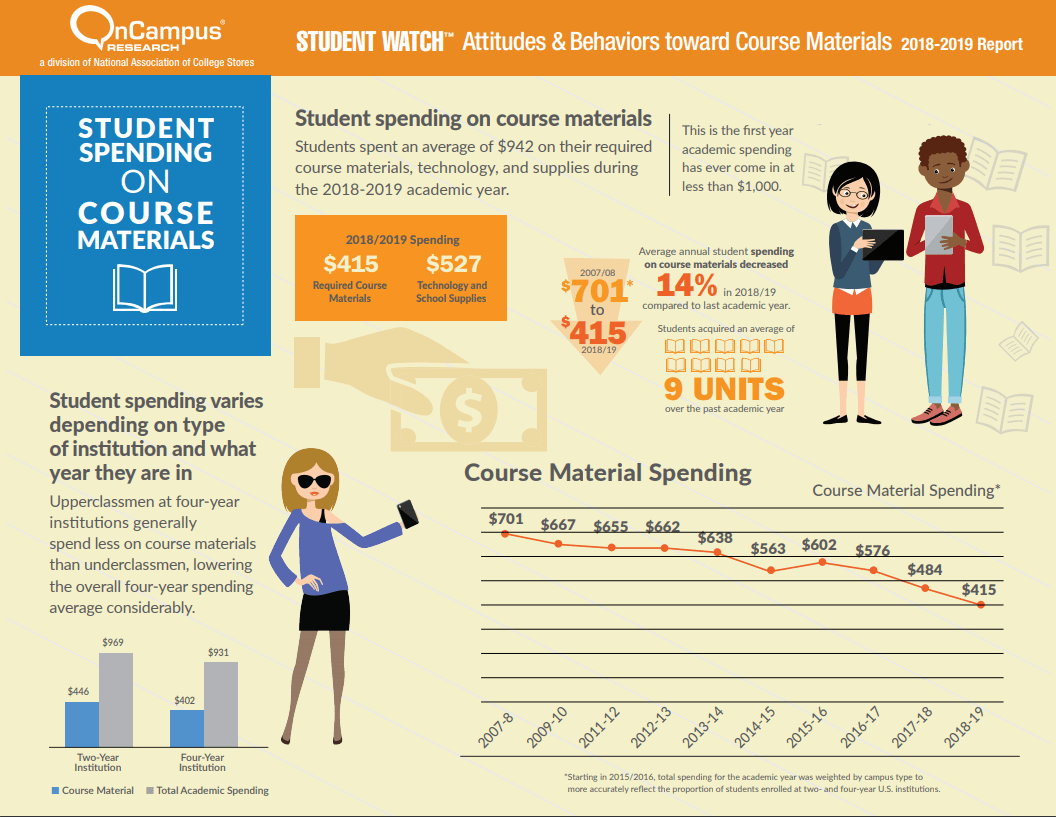NACS Report Shows 14% Decrease in Spending on College Course Materials
Student Spending on Course Materials Declines by 14% In 2018-2019 Academic Year
OBERLIN, OH (July 24, 2019) – During the 2018-19 academic year, college students spent an average of $415 on nine required course materials. That’s down from $484 on nine units the previous academic year, and a decrease from $701 since 2008, according to the Student Watch™: Attitudes and Behaviors toward Course Materials: 2018-2019 Report, the National Association of College Stores’ (NACS) annual survey of college students in the U.S. and Canada. Students also reported spending an additional $527 on technology and school supplies.
“Spending on course materials declined by 14% year over year, which is a significant decline,” said Richard Hershman, vice president of government relations. “Since 2008 spending has declined 41%. It is clear that many of the affordability solutions developed over the past 10 years by campus stores, the broader industry, and post-secondary institutions have led to substantial savings.”
Funded by the NACS Foundation, Student Watch™ is developed by OnCampus Research™, the research arm of the National Association of College Stores. Other highlights from the report, which compiled responses from nearly 20,000 college students in 20 U.S. states and two Canadian provinces, include:
- Course material acquisition remains stable. The number of students who purchased, rented, and borrowed materials has remained stable since 2014. In spring 2019, 83% purchased course materials, 44% of students rented, and 15% borrowed.
- The campus store remains the top source for purchasing and renting course materials. In 2018-2019 79% of students reported they purchased course materials from their campus store, 46% from Amazon, 18% from a publisher website, 10% from a peer/student, and 10% from Chegg.com. Rentals followed a similar pattern.
- Purchasing continues to be the most common method of acquiring course materials. Eighty-three percent purchased materials in 2019. The number of students who purchase materials has remained relatively unchanged over the last four semesters.
- Spending on technology decreased in the 2018-2019 academic year. Student spending on tech items totaled $419 this academic year – a 13% decrease from 2017-2018.
- Eighty-nine percent of students reported using some type of free content. Students reported using a variety of free materials including class handouts, lecture notes, website articles, academic journals, and textbooks. Students acquire free content in a variety of ways. They borrow it, share it, receive it from faculty, and download it. In spring 2019 22% of students reported downloading free content – a 100% increase from the spring of 2016.
- Students prefer print, but print preference is slowly declining. Preference for print over the past three years has been on the decline. As of 2019, one in four students – 26% – prefer a strictly print textbook, down 21 percentage points from it's highest point in fall 2016 but only down 6% from fall 2012 when the question was first asked. The second most preferred option among students is print with a digital component which that includes print books with online access or support. Twenty-one percent of students prefer this format combo which also saw a spike in 2016, but overall is down slightly from 2014. Combining both print-only textbooks and print with digital components, around half of students (47%) prefer print of some type.
- Students are waiting longer to obtain course materials, but price is not the primary reason. In 2019 36% of students reported that they did not have materials on the first day of class. However, price is not the primary reason students wait to purchase. The number one reason is because they doubt if the required materials are really necessary for course work. Another reason students cited for not having materials the first day of class included not knowing what materials were required.
- Students prefer convenience. The campus store continues to be the number one place students go to purchase materials. Overall, 79% of students who purchased a material did so from the campus store. In fact, one-third of those who purchase did so exclusively from the campus store. Campus store sales are made up of both in-store and online sales. More than half (57%) of students purchased from their campus store’s physical location while a lower number (46%) did so from the campus website. Many students do both, which explains why the total number who shop either online or in the store (79%) is less than what each would be if added together.
Members of the media interested in a copy of the report should email publicrelations@nacs.org
About The National Association of College Stores : The National Association of College Stores (NACS) is the professional trade association representing the collegiate retailing industry. NACS represents campus retailers and industry-related companies that supply course materials and other merchandise and services to campus stores. NACS provides education and other resources that help its member stores support student success, the campus experience and the missions of higher education institutions.
About The NACS Foundation: Operating for 36 years, the NACS Foundation is the only philanthropic resource for the campus store industry. Since its inception, it has disbursed more than $3 million for industry education and research, and awarded more than 3,000 professional development grants to college store professionals.





